As a follow up to the excellent report by Malte about the Ralleys, I thought I’d dig out some of the write up I have done about the Vintage Mooneys, which I regrettably never finished to this point and share it here. Let me first ramble on a bit on how I got started with the vintage Mooneys.
M20C HB-DWC taking off from Alpnach Airbase
I got my original licence in 1983, happily flying a Cessna 150 for the next few years. Finally I got my CPL/IR done on Seneca’s (II and III) and then rented a Seneca I for a while. In 1993 and 95 I came as close to as ever to actually move into the right seat of airliners, but both efforts eventually failed. I converted to the Antonov 2 for a while in Bulgaria, but in 1999 I did hang up the pilot’s cap (I never graduated to a hat) I thought for good. Then, in 2008, I got a small financial windfall as well as the conclusion of one of the more stressful periods of my life and decided to get back on board. I wanted a financially viable and at the same time capable airplane to travel with. Several types went through a closer look, the closest I came were an Arrow II and a Cherokee 140. While the former appeared to be too expensive for me to maintain, the latter put me to sleep flying it with a mere 90 kts. After the Senecas I wanted something similar in perfomance.
It was at that time that the owner of the maintenance shop I was about to pre-buy the Cherokee 140 with pointed me into the direction of the Mooney I own today. It’s a 1965 C model, it had a run out engine but was reasonably well equipped and had been well cared for. Comparing maintenance bills I found it to be in between the 140 and the Arrow, interestingly however much closer to the 140 than I thought and was, due to the engine hours, a lot cheaper than both of those. I decided to go for some flying and got back my SEP rating on it. By the time I had about 10 hours in it and my SEP valid again, I decided to buy it. Never looked back since.
Landing at Altenrhein the day the airliner world stood still (Dance on the volcano)
Vintage Mooneys?
Lots of people including myself thought of Mooneys as high performance airplanes well out of the budget reach, so I never really looked at them until this one came along. Later on of course I found that there is quite a distinction between the older so called Vintage Mooneys and the later models, which in Mooneyspeak are called Modern Mooneys. Vintage Mooneys is anything before the “J” Model, better known as the 201. In reality, the Vintage Mooney line up mostly consists of the Models C, E and F, while there are a couple of G’s in the market, there are hardly any D’s at all. Very rarely a wood wing model A will turn up or the predecessor of the C, the B model. I know next to nothing about those, so I’ll leave them out.
In a nutshell, the Vintage Mooneys are as follows:
- C Model: 180 HP O360 A1D, Short Body, manual or electric gear, 52 USG fuel capacity, most built vintage Mooney and only close behind the 201.
M20 C with proud owners at Mengen airfield
- D Model: 180 HP O360 A1A, Short body, fixed gear and prop, 52 USG fuel capacity, most modified to C specs.
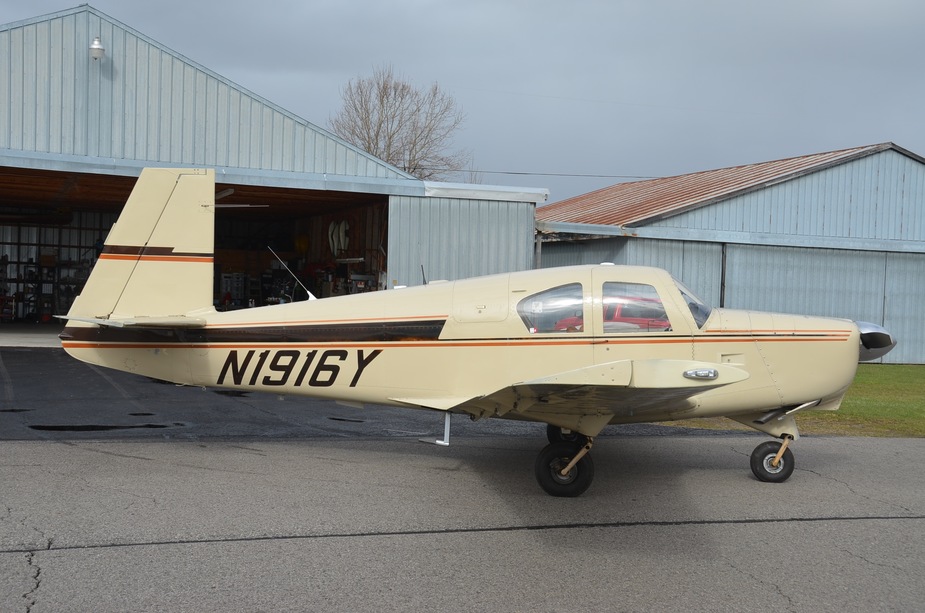
A rare unmodified D Model (eaachapter.org)
- E Model: 200 HP IO360, Short Body, manual or electric gear, 52 USG fuel capacity.
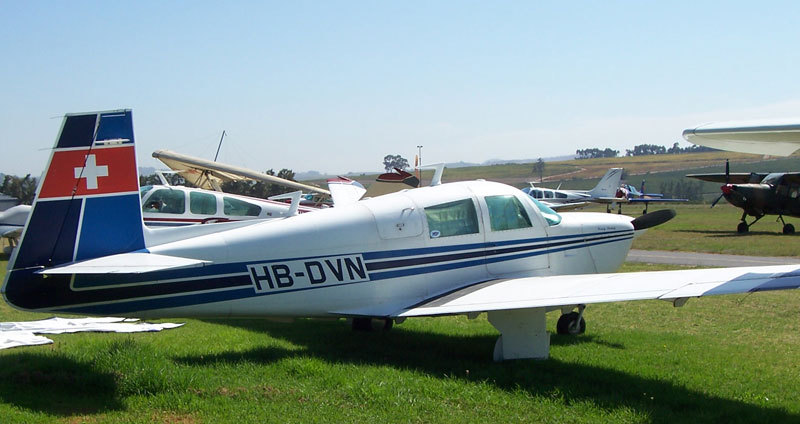
This E-Model belongs to Flaeming and Angela Pedersen and has been modified as a long range airplane. “Honeymooney” as she is called has indeed flewn around the world and across all continents
- F Model: 200 HP IO360, Long Body, manual or electric gear, 64 USG fuel capacity, direct predecessor of the 201. Together with the 201 and 231 which share the airframe, the largest quantity built of any Mooneys.
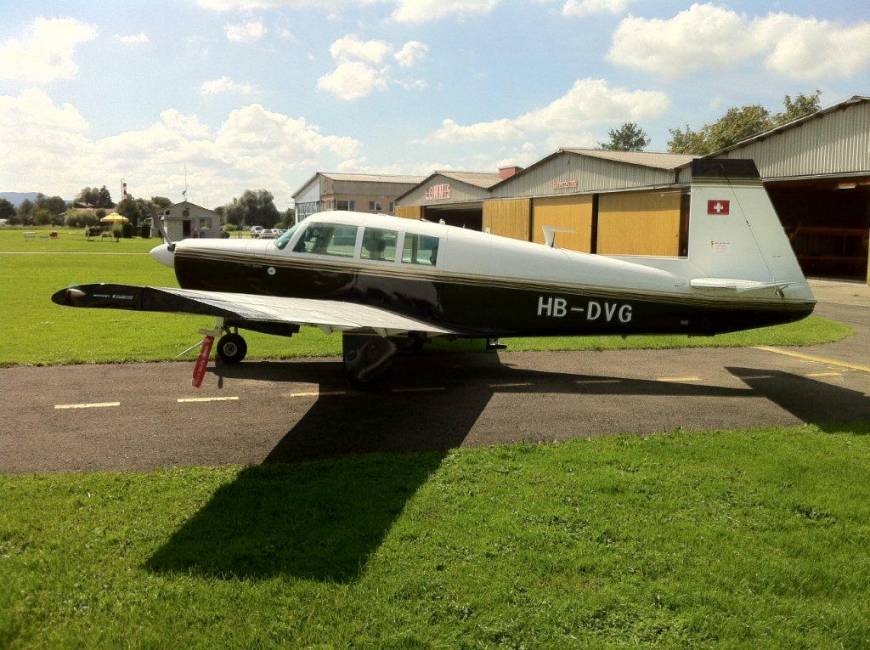
This F Model is based at Lommis. (planecheck)
- G Model: 180 HP, O360 A1D, Long Body, 52 USG fuel capacity. A few dozens built.
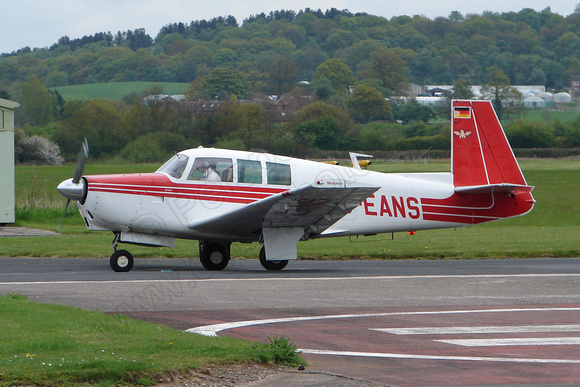
This G model is based in Germany
Of the vintage Mooneys, the C Model ist by far the most popular, as there are many of them on the market and they are usually attractively priced. The E Model is the first real high performance Mooney and is also quite popular when you can get one. The F model is similarly popular because of the longer cabin and because it will cost less than a comparable 201/J.
Short Body vs Long Body
The Short Body Mooneys are the reason why even today a lot of people think Mooneys are cramped and tight. In the case of the short body C,D and E models, this is true for the rear seat bench, which has very small leg room. The Long Body F and G were the consequence of this complaint and feature a full 10 inches more leg room for the rear seaters. In short, the smaller short body planes will be fine for two up front and two smaller persons or children in the rear, it is a squeeze with 4 adults but will do very nicely as a 2 seater with a lot of baggage. For those who need 4 adult capability, a long body is highly recommended.
Performance (M20C)
The M20 C is often compared to the PA28-180 or Archer, as it shares the same basic engine. I would include the Grumman AA5 Tiger into the comparison, as it goes in the same class too.
In the short version, with the same engine and variable prop, a M20C will run 20-30 kts faster than a comparable PA28 and 5-10 kts faster than a Tiger. Going through the Mooney POH, I tried to organize the figures a bit and re-calculated the range figures. This is what I came up with (disclaimer: not to be used without consultation of the POH!)
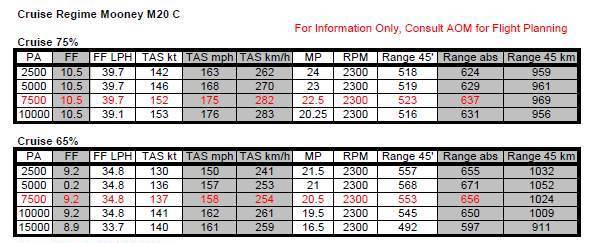
In short: The M20C will cruise quite happily at around 140 to 150 kts with 9-10 GPH and achieve an operational VFR range of 550NM in the process.
The photographic proof: Yes, a C model will make 150 kts if run full out. 2500 RPM and FT at about 10 GPH and 6500 ft.

In long range cruise, the airplane will deliver slightly longer range of up to 600 NM, but at the price of lower cruise speed of 135 kts.
In recent flights (since we can read TAS on the Aspen PFD) we have consistently seen 145-150 kts with 9-10 gph fuel flow. The longest flight we undertook took 4-30 with a roller coaster ride over the alps and we ended up with a fuel remaining of about 40 liters, which is 1-15 flight time. This meant an overall consumption of around 9 GPH.
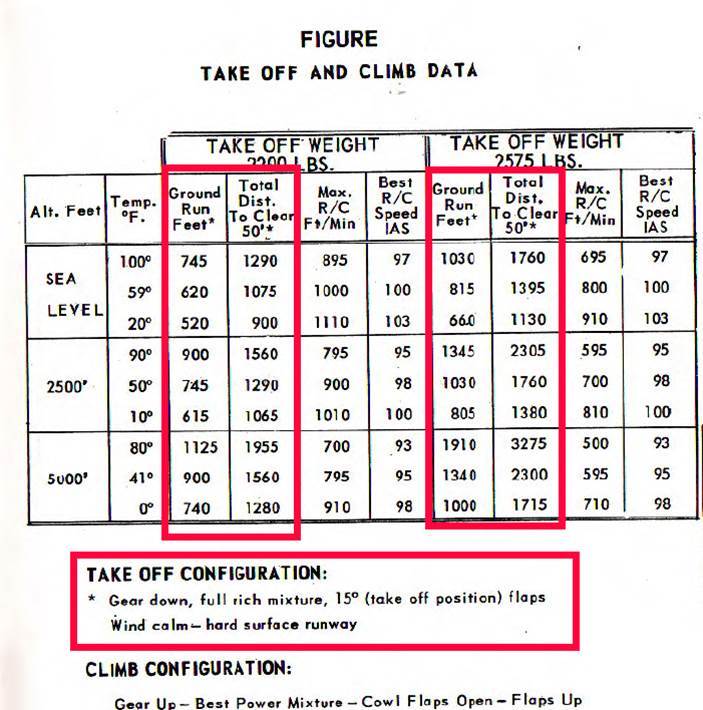
In terms of runway lenght requirements, the M20C is quite good. Ground run at 2500 ft PA with 21°C is under 400m at MTOW, the distance to clear 50 ft is around 620 m, which makes the M20C a pretty good short field performer. In fact, I never really thought that taking off is a problem distance wise, where you need to be able to get it right (speed control) is landing.
Taking off in places like Samedan, which has density altitudes of up to 8000 ft in Summer is never a problem if the engine gets leaned out before take off. With a service celing of more than 17000 ft, the Mooney will climb away quite nicely there. The one bit to observe in such conditions is ground roll and climb to 50 ft, which can take up to 900 m (roll) and 1600 m (50 ft) at MTOW. Once cleaned up, the airplane will climb with 500-600 fpm quite happily.
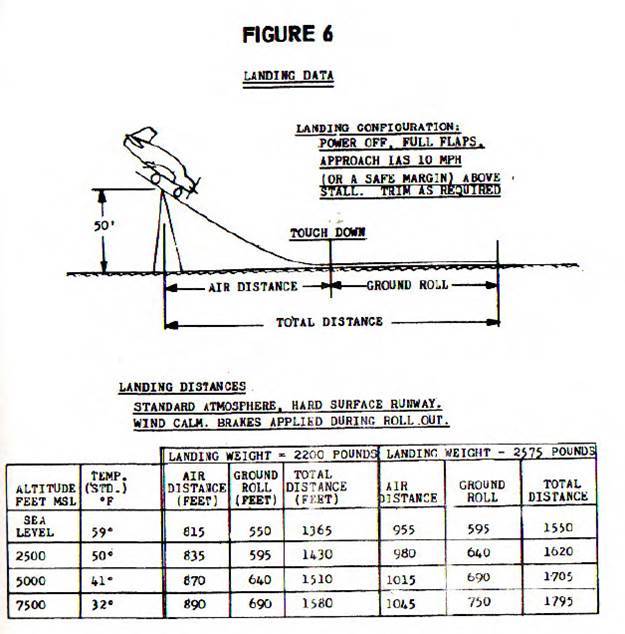
While the actuall ground roll distances are quite tame, the distance from 50 ft is often more than double the ground roll. At 500 m runways, quite some caution must be advised and proper speed control is everything. Similarly, when landing in particular, it is quite easy to flat spot a tire, as the brakes will block the wheels quite easily. With practice however, landing at fields like Wangen Lachen (500m) is quite easy.
For time/fuel/distance to climb/descend, the POH does not offer any tables so I calculated them out myself, they are for information only not for flight planning!
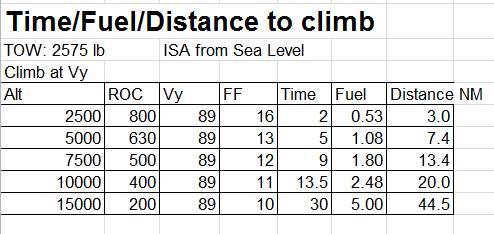
Generally, up to 10’000 ft, climb is quite steady using about 2.5 USG to TOC and 13.5 NM air distance. In reality, this may vary as most people will fly with cruise climb of about 500 fpm slightly faster. The over all fuel burn does not change too much though.
If allowed to cruise climb, the C Model can easily reach 15000 ft and with even more patience up to 17000 ft. My personal “record” was to reach FL170 with an OAT of 0°C which translated into a density altitude of more than 22’000 ft.
For descent, planning is necessary in order not to shock-cool the engine.
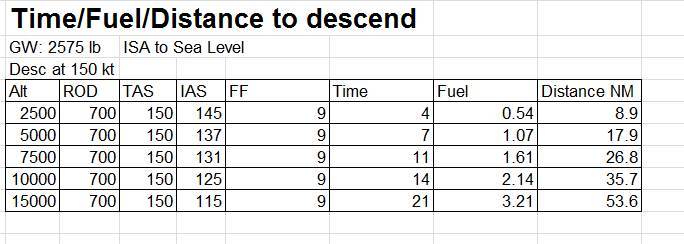
To get down from FL150 to sea level in an orderly manner, up to 50 NM can be required, so descent should be initiated accordingly.
Preflight and ground handling.
The Mooney is conventional to pre-flight, important bits are to really well drain the tanks. The Mooney fuel caps are sunk into the wing to minimize drag but have the disadvantage to leak quite a bit into the tank when not new. I got new caps and filler necks last year, before that we had two incidents where the engine stopped on the ground due to water, to the quantity that when draining, people did not notice it was only water. One bit which I dislike about the Mooney is the strainer which will get the floor dirty but is almost impossible to aim properly into a glass or bucket.
Fuel caps after renovation.
On the ground, the Mooney is not a plane which can turn very tight, so ample room is recommended. Of course one can use the brakes to turn tighter, but it is not a good idea on the wheel structure to do so. Brakes are quite efficient when in low speed, in high speed directly after landing for instance, they can produce flat spots very easily.
Equally important on the ground is to lean quite agressively to avoid fouling of the spark plugs. This is important before departure but also after landing. There is a burn off procedure should the plugs get fouled but it doesn’t always work very well. I’ve had two flights cancelled due to this when the preceeding pilot did not lean agressively enough. Recently I’ve adopted a procedure to run up the engine briefly to 1700 RPM before shut down and do a quick mag check so I can get rid of deposits if necessary right then. Of course this means another few minutes of cooling before shutting down but it’s proven worth it.
Flying the Mooneys.
The Mooneys are easy to fly in general. Control inputs are much more direct than in other types, particularly Cessnas but also Pipers, as the controls are driven by control rods rather than wires. This also makes for good stability. Mooneys will hold altitude when trimmed properly quite well. For longer flights still an autopilot is quite nice to have.
In terms of weight and balance, most C models are quite good load carriers. Mine can carry 383 kgs of useful load, with full fuel it can still carry 250 kgs, which makes for 3 folks of 75 kgs and 30 kgs of baggage or 2 and two kids with bags. The baggage area is adequate, while not oversized it can fit weekend bags quite well. On my trip to Bulgaria, with 2 on bord, we tied down some bags on the aft seat and managed to get over 60 kgs of baggage stowed in the plane without exceeding either weight nor center of gravity. In terms of CG, C-Models are unproblematic as long as there is a bit of material in the baggage area. Otherwise, with two up front and nothing in the rear, it can get outside the front limit.
One mention should be the landing gear. On a lot of vintage Mooneys, it is manual, using what is called a Johnson Bar. In extended and locked state, this bar is locked under the instrument panel and has to be unlocked by hand, then turned towards the floor and locked there. It takes a bit of practice to do this and it should be done with a speed of below 80 kts (retraction). Care must be taken that it locks both up or down. In the down lock, there is a pin which snaps out so it’s easy to see. In the uplock, you better make sure it is really in there, otherwise it can release during flight which is not very comfortable. However, the manual gear is very easy to maintain and also darn near fool proof in terms of not coming down. The only bit which needs to be known is that it is highly advisable to center the pedals before operating the gear, as the front wheel will turn even retracted and can jam in the wheel well, in which case a good kick onto the pedal will resolve the problem but it’s better not to get it in the first place.
Speed control when landing is quite essential. Mooneys will float a lot if landed too hot and use multiple runway ground roll figures in the process. Similarly, during descent, it is essential to see that you actually get to the speed to lower your gear. Doing a high speed ILS is possible if there is enough ceiling to sort yourself out once you are down below the clouds and a long enough runway. In places like LSZH, where there is a 3200m runway in front, it is easily possible to fly at airliner speeds down to 500 ft or so, then level off (VMC) and get the speed back to 120 mph to extend the gear and land in the last 1000 m of the runway, which is also appreciated by ATC as that is where the exits are. This does not work on a short runway though. Vref should be about 10 kts above Vs for the configuration.
Carburettor Ice is quite common on the M20C and G. The usual tactics help and a carburettor temp indication is highly recommended.
Changing fuel tanks is a bit of a sportive exercise for those who are a bit heavier built like me. Whoever decided to place the fuel cock in that position should be made to use it for a few hours as punishment, but they did move it in the later models. I usually put my feet over to the right hand side and then lean down to do it, some people have made themselfs a T-Handle, which I eventually will do as well. Fuel tank policy by Mooney is to fly 1 hour on the first tank, then change to the other until it’s dry and then fly the first tank to the end. My personal addition to that is to actually change the tanks at least once on the ground before departure and let it run for a few minutes to make sure there is no water i overlooked. If there is, you’ll know within about a minute.
Other than that, the C model is a joy to fly. It is a stable instrument platform and it has just enough power and speed to make travel nice. All Vintage Mooneys are well at home on small grass runways as much as on large airports.
The E and F models feature 20 hp more, which translates in about 10 kts more speed. The E will deliver 150kts TAS at the same burn off as the C model, the F will do about 145-150 kts TAS, both can do more if flown max cruise, but economically they are about 10 kts faster than the C and G model. The F model in particular sticks out from the other Vintage Mooneys by having 12 USG more fuel available. That is quite useful for longer trips or trips to isolated destinations (with the nearest alternate an hour or so away).
Approaching Rijeka, Croatia
Over the Black Sea near Tsarevo in 2011
At Primorsko (LBPR)
Maintenance
The Vintage Mooneys are quite easy on the pocket book on maintenance. Parts are readily available, if not always straight from Mooney, people like Don Maxwell are able to help really well and fast.
Gotchas are leaking tanks (which usually are a result of hard landings) which will require a re-seal. There are specialized shops also here in Europe who do this. Other than that, maintaining Mooneys is quite straightforward and won’t set you back much more than maintaining a Cherokee. Some older Props have an AD on them which requires to check the hub for cracks. This hub can be replaced at the cost of about 5000€, which makes it cheaper to have it checked every 100 hrs at about 200€ per check.
It’s important to have someone work on your plane who knows Mooneys, particularly when doing the pre-buy. There are quite a few reputable Mooney shops around in Europe though.
Pre-Buy:
If at all possible, a pre-buy should be done at a Mooney Service Center or with someone who knows Mooneys well. Things to look out for are:
- Leaking tanks. These should be addressed before purchase. If they do leak, there are two ways of correcting it: Re-seal or bladder tanks. There are bladders for sale which actually add the same 12 USG to the C Model than the F model has, which is a bonus for that.
- Leaking fuel caps. Do a good check of the fuel fillers and the caps. Most Mooneys now have the newer filler necks, the older ones are prone to corrosion and can leak badly. As Water will collect in the fuel caps with nowhere to go, you should be extra careful there.
- Main Spar Corrosion. It is rare but it has been known to wreck otherwise well kept Mooneys. Your Service Center will know how to look for this problem and if there are traces, how to remedy the problem.
- Landing Gear Rubbers: The landing gear sits on rubber bisquits, which is nice because they won’t ever require refilling or leak. However, they need to be replaced every few years.
- Run out engines and props: On Condition engines are not a problem anymore mostly, due to ELA1. The C, D, E models are ELA 1, so there the real condition of the engine is the big deal. If it is good for a few hundred hours, nice, if it has to be done, then you might as well calculate it into the price and go with an overhauled one. The prop has a TBO of 6 years, which costs about 1500 Euros at MT propeller and may well be worth it if it has not been done a long time. My plane gained 5 kts and a lot quiter running after modifying the prop.
Upgrades:
When I got my plane, this is what my panel looked like.
Today, it looks like this.
Current panel of my airplane with Aspen PFD and GNS430W and S-TEC 55X AP/FD
When I got my plane, the panel was already quite updated in terms that it had the T-Layout and a quite complete radio stack. So my priority was to get the 2nd altimeter and HSI I needed for IFR. The ASPEN EFD1000 was the ideal solution for that. I also wanted an Autopilot, so I added an S-Tec 55X which at the time had a promotion (same price for the base unit as the System 30) with FD and Autotrim. I am very happy with this setup today.
Quite a few Vintage Mooneys come with so called “Shotgun panels”, the expression coming from the idea that someone fired a shotgun at that piece of metal designed to become a panel and then randomly put clocks inside. Others have later panels which have the conventional T-Layout up to the 201 style panels in 1970ties production. Quite often, it is much easier to actually getting rid of the whole panel layout than to experiment filling the existing one.

This is what a older panel may look like.
When upgrading, care has to be taken for the not that ample panel space. While it is possible to put G500 style avionics inside, most Mooneys will struggle with larger GNS boxes unless the stack is cleared out totally. However, Aspen PFD’s will render a lot of instruments obsolete while leaving space for stand bys. I’ve also recently seen one C model which did get a full GTN upgrade with a big and small box.
This is what one mooneyspace member has done to an E-Model:
What is good to have up front is an autopilot, even a S-Tec 30 or 50 will do nicely. Brittain Accu Flite or Tru Track can be augmented with a S-Tec 30Alt or PSS 60 system to have altitude hold or a full vertical channel. If they work, they are not really neccesary to replace.
Mods:
There are quite a few modifications available for the Vintage Mooneys.
- 201 Style cowling and windshield: Very desirable. The windshield can be put on all the vintages, the 201 style cowl only on the ones with the 200 hp engine. For all of them, there is also a cowl closure mod available, which increases cooling of the engine and delivers some 1-2 knots of speed. The 201 windshield will bring about 5 knots but primarily it will offer a dashboard worth mentioning and give the cabin a bit of a more spacy look and feel.
- Monroy Tanks. This mod allows to seal two additional compartments in the wing, adding 36 USG of fuel. That translates into 3 hours at 140 knots or at quite some money if you have weight to spare in Belgrade. Of course it is important to be careful with the loading afterwards, with full fuel a Monroy Mooney will be a real two seater. But it can fly over 1200 NM with it too. The aforementioned Honeymooney has got an endurance of over 20 hours with additional tanks and that is how it managed to fly the Pacific ocean. A “normal” Mooney with Monroys will get up to 10 hours endurance. This will even enable trips to Oskosh over the NATL with a C or E model, which are a bit tight on the UK-Iceland leg with standard tanks.
- Rajay Turbochargers. There are some vintage Mooneys which have those. They can reach speeds up to 180 kts up high.
- Powerflow Exhaust. Well worth the expense imho. My plane came with them and they will give an additional 5-10 knots of speed. My plane will reach 150 kts flat out which is due to those. If flown to normal specs, it will allow to fly with the book speeds but slighlty less fuel flow.
All these are installable in Europe as there are examples which have them. For N-Reg planes there are plenty more.
Conclusion:
The Vintage Mooneys are very nice entry level travel machines which give the owner a lot more performance than comparable 180-200 hp airplanes at insignificantly higher cost than a usual fixed prop/gear offering and significantly lower maintenance cost than some retracables. They are quite inexpensive to get these days due to the fact that even the modern Mooneys (201, 231 and later) have come down in price significantly. A good VFR equipped C model can be found in between 30 and 40k, with good IFR a bit more, E models are usually similar in price with F models a bit higher.
When looking for an inexpensive plane which is used for travelling, primarily for 2-3 people or 2 adults with 1-2 kids, Vintage Mooneys should be taken into consideration. I have never regretted my choice one bit.
Thanks for reading. I hope that other folks will come up with Pireps for their airplanes. I know there are quite a few in this forum which would be interesting to read more about.
(PS: It might be nice to get a preview mode one day to avoid all the edits :) )
Mooney driver another great write up on one of my favourite types. I nearly bought an E once which I think now lives in Slovenia (G-ATOU), and I was sorry I missed the chance. It was pre 1967 which apparently enjoy a better build reputation (not sure why).
My only Mooney time was on a 201 M20J which I regard as one of the best cross country GA aircraft ever produced – even if they go against my bias for more simpler, agricultural types!
Mooney Driver. Thanks, I read that with interest. A very concise, and thoughtful précis of the type. Liked the photographs also. Anyone thinking of buying one, would do well to read this, written from a person who operate the type. If I get time, I will use your format to do a report on the Vintage Bonanza’s……
Thanks guys.
RobertL18C wrote:
I think now lives in Slovenia (G-ATOU),
And I know the guy who owns it  Great airplane indeed.
Great airplane indeed.


Joze, who owns it now, is a great guy. He upgraded from a Piper Cherokee 140.
Very nice aircraft and nice report, Urs. I always liked the Mooney for their efficiency, but my wife doesn’t sit too well, although we just tried the Acclaim with the high panel. Perhaps the vintage Mooneys are more suitable.
Thanks Malte. You were the inspiration for it :)
I never have been in an Ovation (not for my lack of wanting) but yes, the panels in the old ones are lower. I tried to get some pics on this. My wife has no problem sitting in it, even in the back.
Pic taken from the back seat
3 on bord.
My normal seating position
This is about the eye height.
It was amazing that the D model came with fixed gear but was designed to be upgradeable to retractable….and most were….
Also many of the manual “Johnson bar” retractable gear systems were upgraded to electric….although I note that MD still has the manual gear….
They also had a pneumatically actuated retractable step…to reduce drag….
Brilliant machines….
Just sitting would not been the problem, she would be flying and position of Rudder pedals to yoke and throttle felt a bit odd to her. We’re not in the market for an IFR tourer at this time, anyway.
Anthony,
yes, I would not want to change the manual gear for anything, nor the flaps. It is darn near foolproof and has so far never been blocked in uplock in the over 50 years it exists. One has to be careful with the downlock and verify it (my wife used to be worried I would tear it out of the structure,but that is how you “yank your Johnson” before landing) but otherwise it is very easy to maintain. Flaps are a bit less maintenance friendly, particularly if one does not take care with Vfe, they can start leaking.
AnthonyQ wrote:
They also had a pneumatically actuated retractable step…to reduce drag….
Yes, I do have that step indeed. Works well. Just you remember that it retracts whenever the engine is running if someone gets out while it is…
Here you see it
Here you don’t.
Malte, you’re welcome to try it whenever we get together hopefully some time :)
Old thread but I’ll give it a shot. Very nice write-up and the older Mooneys seem to deliver a lot of capability for a fraction of the price of more modern competitors. Could you be a little more precise though as to how much difference the manual gear and hydraulic flaps makes on maintenance costs vs. the electric versions?